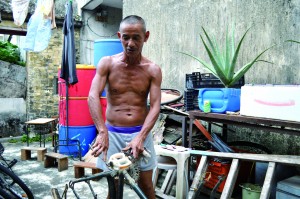Under the current policy, the qualified indigenous villagers can only build their small houses within the ‘V’ zone and the environs of the extension area of their own village. In other words, even if the villager owns land outside his village, he cannot build his Small House there. “The government has given us an ultimate restriction by limiting the land. It won’t increase the size of ‘V’ zone even if it expropriates land for development,” says Tang Wah-ching, village head of Sik Kong Village at Tin Shui Wai.
Like many other villages in the New Territories, Sik Kong Village faces the problem of a shortage of land available for building Small Houses. Tang further explains the government resumed most of the land surrounding the village for the development of Tin Shui Wai.
Worse still, due to the huge number of applications, even if villagers privately own plots of land, they still need to wait for around seven years before they can build a small house. According to the Development Bureau in 2012, there were more than 10,000 applications for building Small Houses waiting to be processed.
Tang is frustrated at what he sees as urban dwellers’ misunderstanding that indigenous villagers are born with the privilege to build a house. “The name of the policy remains but the reality is gone,” says Tang.

Apart from land, money is another major concern for indigenous villagers. Sixty-something Wong Cheuk-kai has spent his entire life in Sha Po Village in Yuen Long. He says building a small house would cost more than one million dollars, which is definitely out of his reach.
With a lack of land and money, some indigenous villagers have found other ways to get something out of their ding rights – by selling them. Usually, the land in a village is owned by just a few indigenous villagers. These landowners tend not to transfer the land to their fellow villagers but instead cooperate with real estate developers to build housing estates and other residential complexes.
The developer buys land in the village from villagers who own the land and buys ding rights from those who do not own land. The developer then builds houses under the name of the villagers who sold their rights and resells the houses after paying the land premium. Both parties can profit from the money earned.
However, such developments may actually violate the law. Chu Hoi-dick, a member of the executive committee of environmental group Land Justice League, points out that selling ding rights to real estate developers is illegal because it violates the declaration made by indigenous villagers when they apply to build Small Houses.
The declaration clearly states the applicant should not enter into any arrangement or agreement with any person or persons to transfer, alienate, dispose of or otherwise deal with his rights.
Against this background, the government’s disclosure that it had set aside two and half times as much land for village-type development compared with other residential and commercial use sparked criticisms that it will further encourage the abuse of ding rights.
However, Bowie Hau Chi-keung, the chairman of the Sheung Shui District Rural Committee, thinks it is legitimate to cooperate with developers to sell Small Houses for profit. He says it is the villagers’ freedom to rent or sell their rights. “What’s wrong [with selling ding right]? If you don’t want to live in a Small House, just sell it to other people. Take it or leave it, it’s normal.”
Hau runs his own Small House business and has built more than 100 Small Houses in Sheung Shui by purchasing ding rights and land from other indigenous villagers. He says he will definitely continue to purchase land and build Small Houses.










































